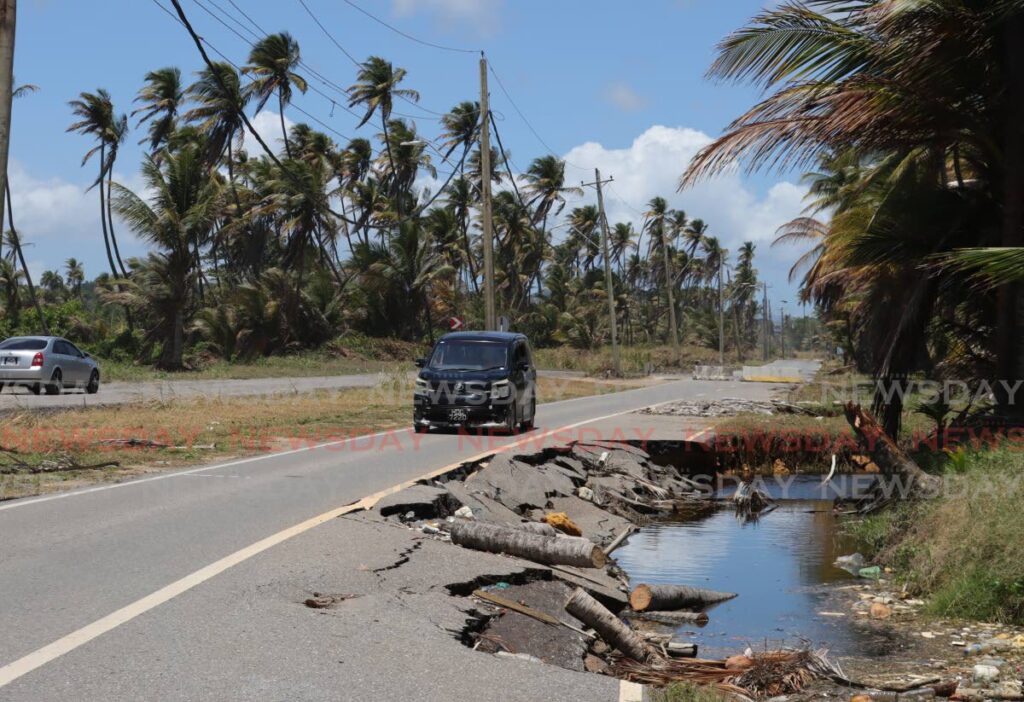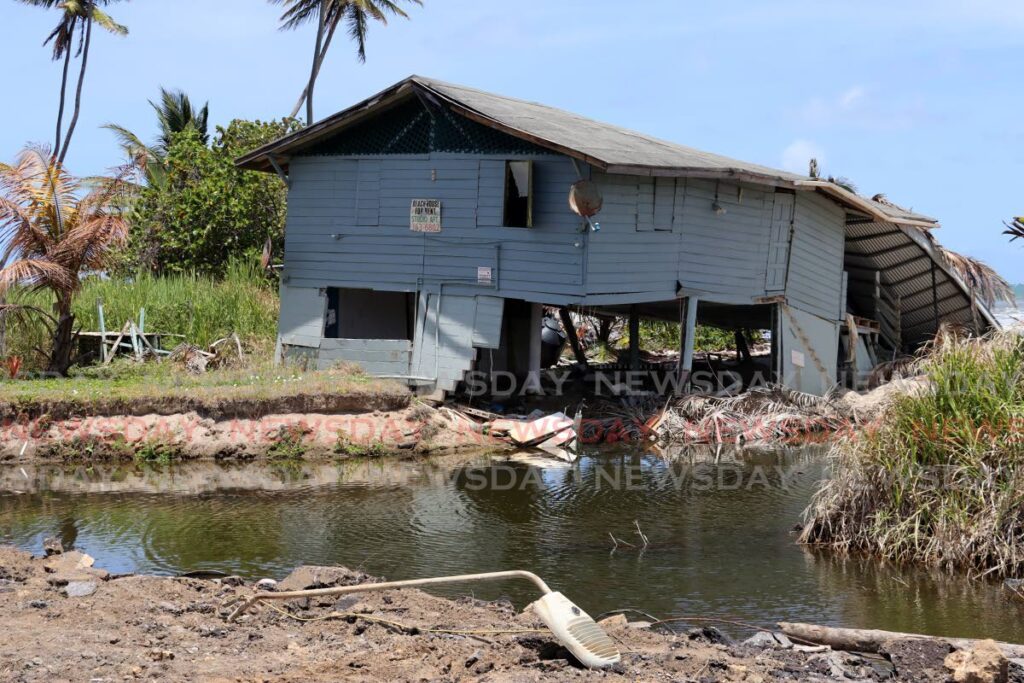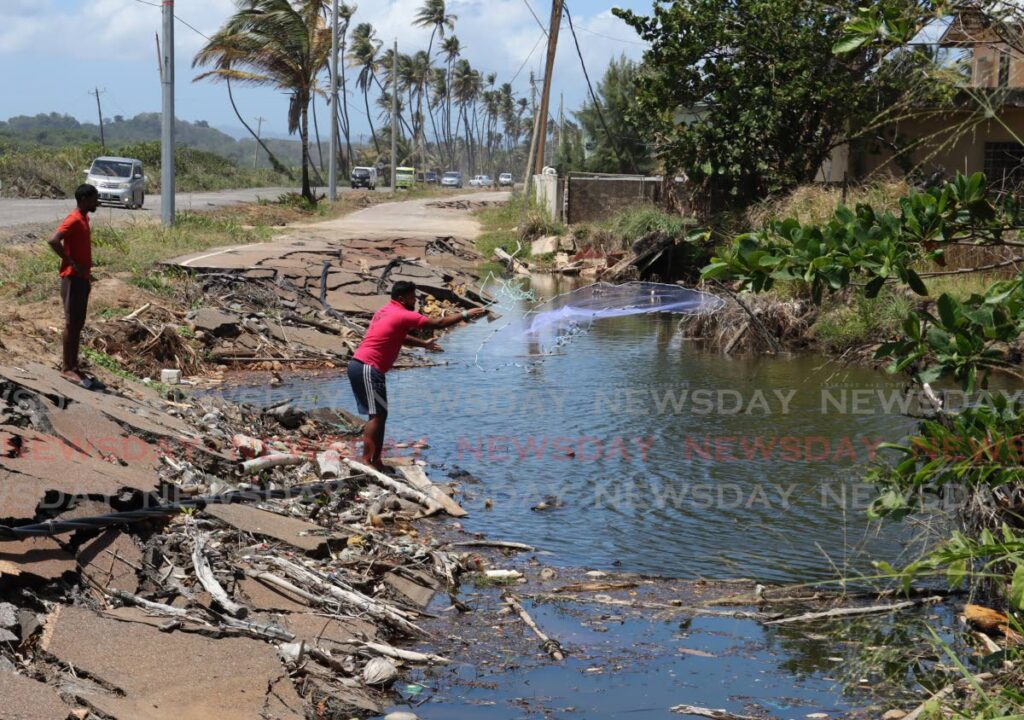No easy fix for Manzanilla/Mayaro Road, says Works Minister

RESIDENTS of Rio Claro, Mayaro, Manzanilla and other areas connected by the Manzanilla/Mayaro Road which was severely damaged in floods during heavy rains in November last year, are complaining that the temporary road is driving some of them to the poor house.
While taxi drivers complain about the damage to their vehicles, commuters are complaining that the commute into Sangre Grande and other areas has become very uncomfortable, and getting transport has become a major issue.
Residents who once lived along the seaside houses say they have not been able to access their houses for months.
The road had been closed for weeks after the flooding disaster and the Ministry of Works carved out temporary roads through the coconut fields on the side but heavy trucks and speeding cars quickly eroded the crushed asphalt surface leaving a maze of potholes.
On Saturday, Works and Transport Minister Rohan Sinanan lead a team of officials to visit the site.

Newsday spoke to drivers on the Mayaro and Manzanilla taxi stands in Sangre Grande who all complained about the road’s condition which is forcing them to go to the mechanic regularly to repair their suspension and other mechanical parts.
“It’s deplorable,” said one taxi driver on the Manzanilla taxi stand. Another quipped, “You have to pick up your car to pass there.”
“Some drivers would even prefer to pass on the damaged road than on the temporary one.”
Taxi drivers said the temporary roads have caused extensive damage to several cars since the road was opened in January.
“Tell the minister to come and drive on the road then he will stop talking nonsense,” said a fisherman “This bad road is affecting me very badly. I came with a taxi driver and the piece where they repaired you can’t even pass because it is only boop, boop, boop going down the road.”
Taxi drivers on the Mayaro taxi stand also complained of the road’s conditions.

“The main hospital for the area is in Sangre Grande. We don’t have any proper hospitals in Mayaro and Rio Claro, so you have to come to Grande,” said Ronald “Conductor” Hernandez.
“There are ageable people and young people travelling on these roads. Right now, every other day you have to go to the mechanic for some kind of repairs because the road is simply not fit for driving.”
Taxi drivers said that despite the challenges of traversing the road, they still have not taken the decision to raise fares, out of concern for the commuters.
However, one commuter, Rebecca Thomas, from Guayaguayare said she has to pay close to $120 to get to and from Sangre Grande from her home and she has to go the health centre in Sangre Grande twice a week.
“If the drivers raise the price we can’t get vex,” Thomas said. “At the end of the day when I look at what these cars have to go through, the amount of money that they would have to spend on suspension (repairs), it is all kinds of things they would have to fix.”
Responding to questions from Mayaro MP Rushton Paray on Wednesday, the Minister of Transport said that high speeding and heavy trucks are damaging the roads. The $12 million temporary road which uses milled material has a 40 km speed limit.
During Newsday's visit, several heavy vehicles transporting tonnes of lumber, construction materials and heavy equipment were seen speeding on the temporary section of the road. Drivers were also seen veering off the temporary road and driving along damaged section.
Speaking with Newsday on Thursday, Sinanan said the Government is making every effort to have the road repaired before the rainy season in June, but there are major challenges of rebuilding the road which engineers are working on getting around.
He said the biggest of these challenges is the terrain where the road passes.
“This is a road that is battered on one side by the Nariva Swamp and battered on the other side by the (Atlantic) ocean,” Sinanan said.
“The road is almost below sea level in most cases so you have to make sure that the swamp can drain and you have to make sure you're protecting your flow from the ocean. So it will definitely take us some time to get to that point that we don’t run into the same problem here where we spent a lot of money to rebuild the road and within a year or two, we got this level of rainfall and the road goes again.”
Observing that the road would not be able to withstand the rainy season, Sinanan said as soon as they find a solution of building the road with materials that will not harm the environment, the government will put out a tender and work will start.
He also responded to claims made by residents in the area that the blocking of a river in the construction of a family home in Manzanilla triggered the flooding in the area last November.
Sinanan said his house was built more than 20 years ago, and it was established by two reports, one done in 2013 and another done more recently that the construction of his family’s home was not the cause. He doubled down on statements he made earlier, saying that there wasn’t even a river there.
“It was established that there wasn’t any river there, and up to now, it still doesn’t exist,” he said.
He said the cause of the flooding is more likely because of a change in weather patterns owing to climate change and the fact that the Nariva Swamp is one of the largest wetlands in TT with more than 235,000 acres of swamp land.


Comments
"No easy fix for Manzanilla/Mayaro Road, says Works Minister"